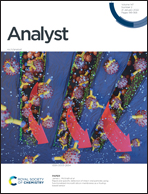Rapid IRMPD (InfraRed multiple photon dissociation) analysis for glycomics†
Abstract
Infrared vibrational spectroscopy in the gas phase has emerged as a powerful tool to determine complex molecular structures with high precision. Among the different approaches IRMPD (InfraRed multiple photon dissociation), which requires the use of an intense pulsed tuneable laser in the InfraRed (IR) domain, has been broadly applied to the study of complex (bio)molecules. Recently, it also emerged as a highly relevant approach for analytical purposes especially in the field of glycomics in which structural analysis is still a tremendous challenge. This opens the perspective to develop new analytical tools allowing for the determination of molecular structures with atomic precision, and to address advanced questions in the field. However, IRMPD experiments require non commercial equipment or/and long acquisition time which limits the data output. Here we show that it is possible to improve the IRMPD performances by optimizing the combination between a linear ion trap mass spectrometer and a high repetition tuneable laser. Two orders of magnitude are gained with this approach compared to the usual experiments ultimately leading to a completely resolved spectrum acquired in less than one minute. These results open the way to many new applications in glycomics with the possibility to include IRMPD in complex analytical workflows.



 Please wait while we load your content...
Please wait while we load your content...